Following on from the simple CW touch keys in the previous page, this page shows a capacitive touch project which is the ideal touch sensitive key solution. The project described here is a iambic capacitive touch key which uses 2 AA size batteries for 3v power, draws <1mA current and has an ‘on’ switching resistance of <0.1Ω with a 3v supply.
The circuit diagram schematic is shown below.

Figure 1: Capacitive touch key circuit. Data sheets: AT42QT1011 | IRFML8244TRPbF
The circuit in figure 1 uses all surface mount (SMD) components. One reason for this is that the IC is only available in surface mount, but the reason for the use of SMD for the whole circuit follows:
|
When designing this circuit, I was going to power it with a 9v PP3 battery, through a 7805 5v regulator. This would have allowed the use of many logic level MOSFET’s, of which I was going to use the 2N7000 which has a TO-92 case. The problem with 5v supply to the AT42QT1011 is that at 5v, they draw around 1mA each. Add on the losses involved because of the 7805 regulator and overall, its just not ideal for power consumption. A transistor could have been used, but I prefer the use of a MOSFET to keep the circuit power consumption to a minimum and it saves adding a base resistor into the design. Also, there’s just something about MOSFET’s, isn’t there? Oh, maybe that’s just me!I did some tests at varying voltages for the current draw of both devices together plus the on resistance of the MOSFET at the corresponding supply voltages and the results can be seen in the table on the left. I decided that 3v would be a good supply voltage, which is easily obtained by two AA or AAA batteries, and the circuit would draw just under 1mA. The regulator would then not be needed and the battery capacity with AA’s would be much more than the 9v PP3. This means that the battery life using alkaline AA’s in this circuit is well over 3000 hours. Of course, you could use a 7805 5v regulator and power this from your 13.8v supply instead of using batteries if you didn’t plan on moving it around too much. |
The problem with using 3v is choosing a MOSFET with a low enough gate threshold voltage. Whilst searching for suitable MOSFET’s, it became clear there was no good candidate which was not SMD. Its a fact nowadays that SMD components offer much greater choice over their through-hole ancestors.
The MOSFET that I chose was the IRFML8244TRPbF which has a typical gate threshold voltage of 1.7v and a very low on resistance and comes in a SOT-23 SMD package. It was therefore decided to design the whole circuit around SMD parts. Many other logic MOSFET’s will work ok in this circuit, such as the IRL540, which comes in a TO-220 package and will switch up to 28A!
So, I had designed the circuit, tested the circuit, all that was left was to design the SMD circuit board, which I did with Eagle. The testing board I etched with photo resist PCB and developer. It worked fine and looked OK, but I decided as I had put the effort in to designing a board for this project, I would get some PCB’s professionally manufactured. The final design can be seen below. The PCB dimensions are 57mm x 37mm.
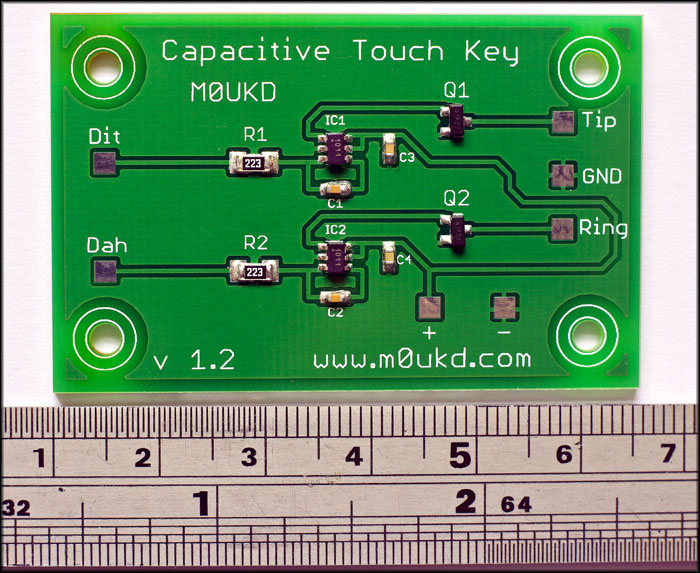
The completed board.
If you would like to photo etch a board yourself, a mirrored PDF file can be downloaded here. I have no boards left for sale at the moment.
Below is a video of how to solder the board using solder flux and hot air.
Below are some photos from people who have made keys with this board…
Below is a video from Stefano, IK5XCT who built the key. An interesting story is that as he says on the YouTube page, he had a contact using the key with DK7FH, who was also using one! Thanks Stefano!
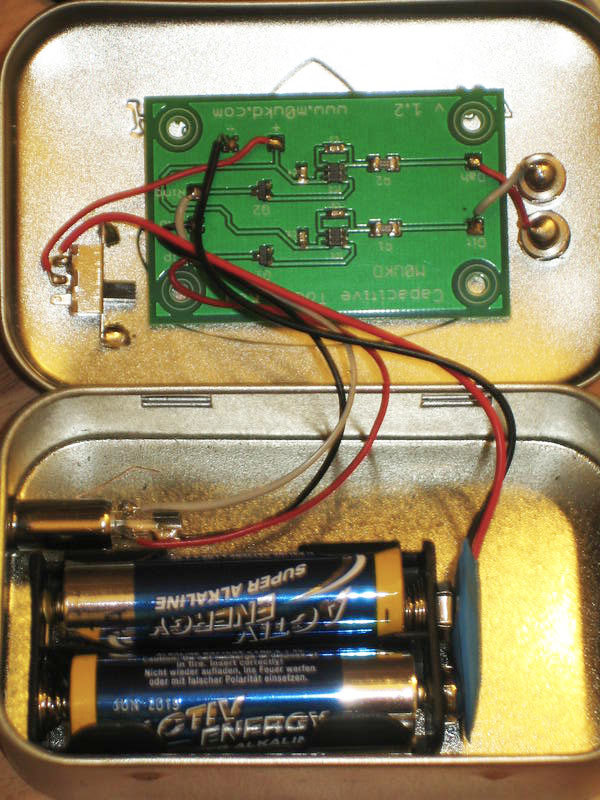
Frank DK7FH built it in a small steel container. He has some more QRP projects on his QRZ.com page.
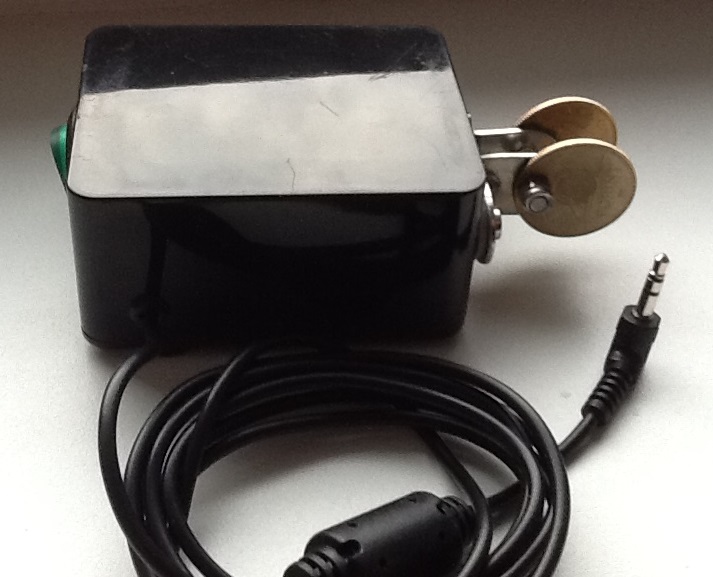
Istvan HA5CLF spent some money on his paddles! He used two coins for touch surface. They are 20 Ft each = 0.05 GBP!
If you decide to build any of the circuits listed on this page, I would be interested to know how you got on. Please drop me an email by going to the contact page. 73 de MØUKD.

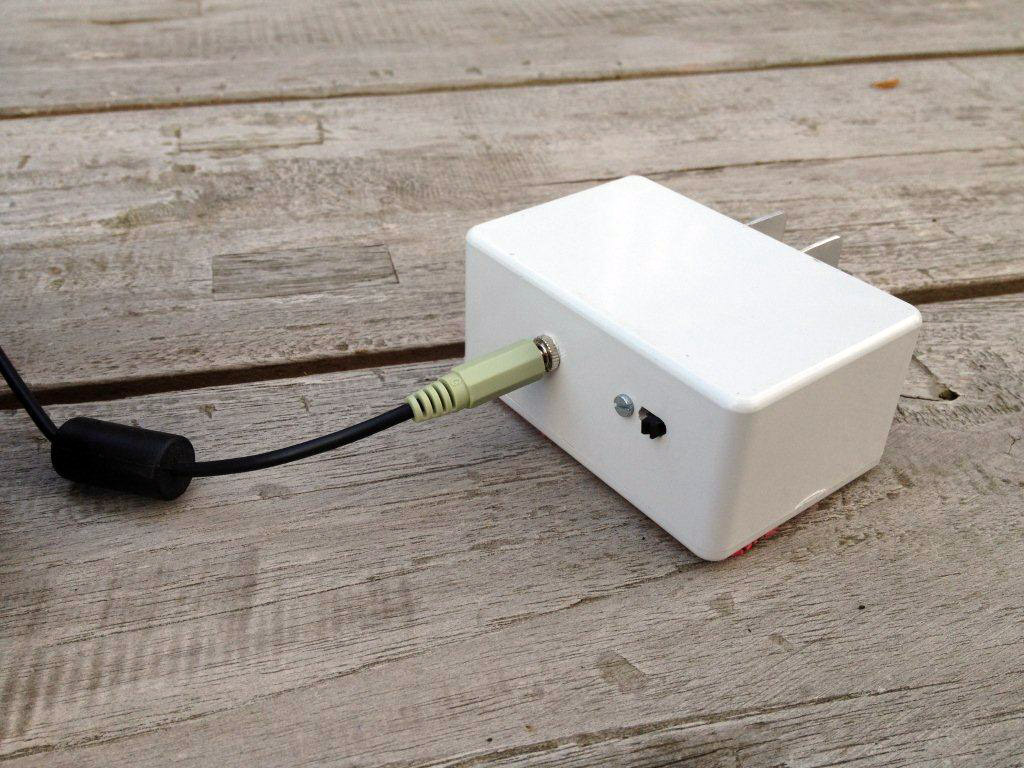
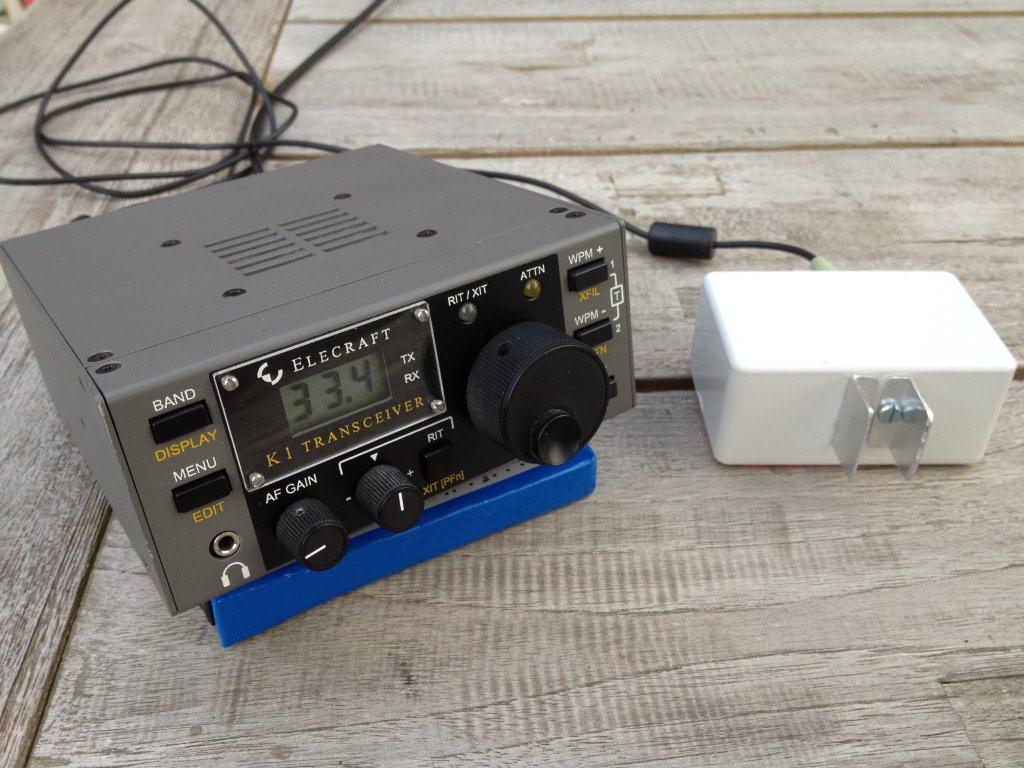
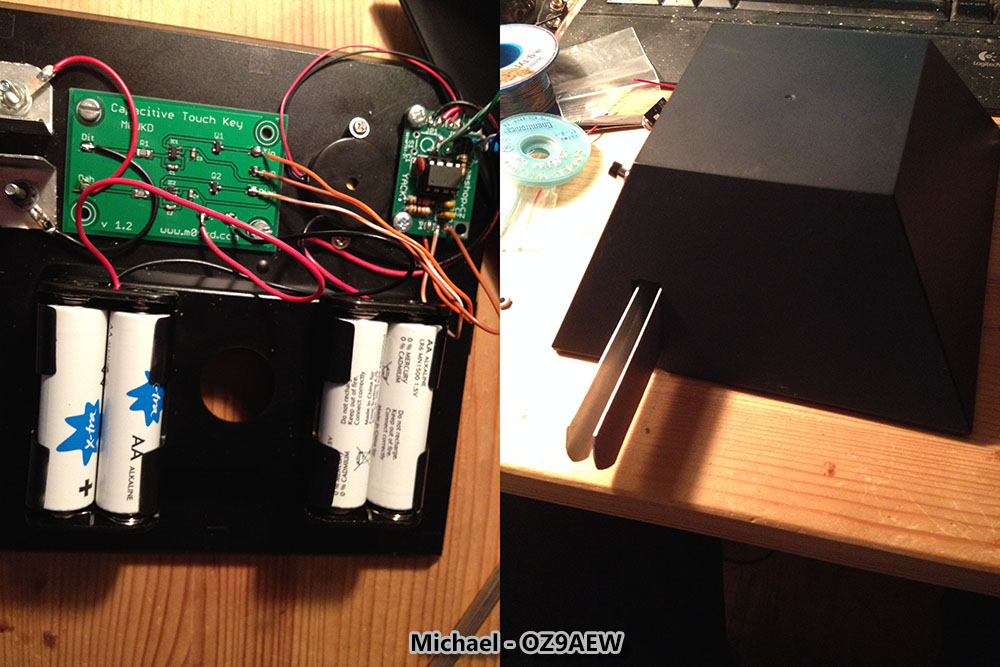
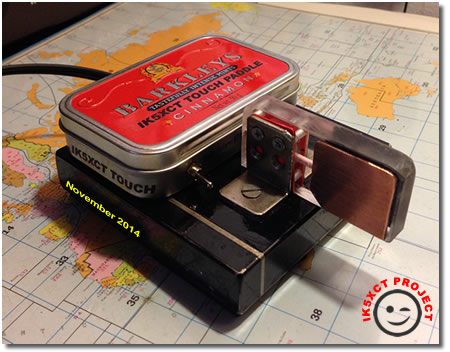

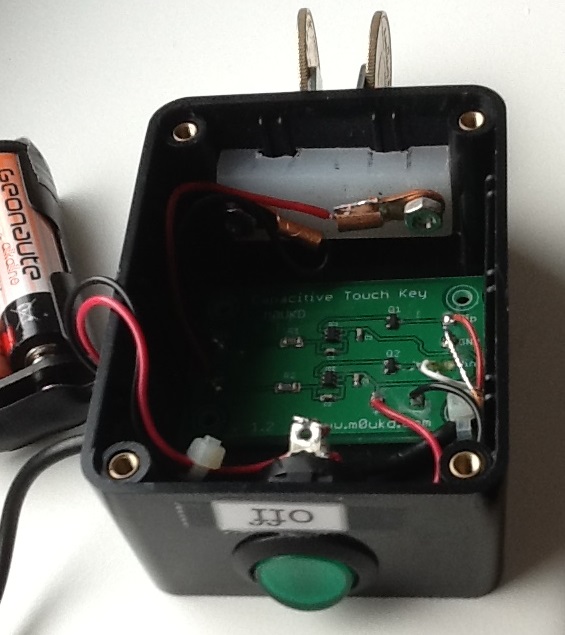
Sorry for my poor English …
Could you confirm a purchase via paypal a circuit and its components for France, 2 chicken right, 4 cow left … Deep in the countryside via Paypal if is it possible…
Excellent achievement …
Pascal / F4CVM
73 to you and your family…
Your YouTube video showed a really nice set of finger pads for this project. Did you hand craft those or purchase those ready made. I’m trying to complete my project but don’t have a nice looking set of finger pads.
Hi Ken.
These were made from angled aluminium from B&Q. It come in a 1m length, but I cut little pieces off to make the touch pads.
Cheers, John.
Hello John
is the Complete circuit board(Built and tested) are available again and shipping to germany possible ?
vy 73,
Kurt – DF4XX
Hi Kurt.
No, I have no more IC’s and need to order some. I will mail you when I get them 🙂
Regards, John.
Do you have any bare boards available at the moment?
Hi David.
Yes, I have a bare board. I have sent you a message.
Hi, John
In this moment, a possible buy your key?
shipping to Russia
or tell me when can I buy.
Respect, Sergey
Hi Sergey.
Yes, I have some circuit boards, if you would like one.
73, John.
John, how much for 3 bare circuit boards shipped to USA?
Tnx, Mike
I’ll drop you an email Mike.
hi! beautiful construction! is it possible to buy the climbed on circuit?
Sorry, what do you mean ‘climbed on’?
What’s the battery’s life on this key?
It’s in the text. The battery life using alkaline AA’s in this circuit is well over 3000 hours.
John.
How much current can the output sink?
Hi Dave.
Its a tricky question, as it depends on the gate voltage. As the maximum voltage we can have for the IC is 5v, that’s also the max gate voltage we can get out of the IC. The datasheet for the IRFML8244TRPbF states at a gate voltage of 10v, we can have a drain current of 5.8A at 25c. It should be OK for at least 1A as it is with a 5v supply.
It would be easy to add on a higher power MOSFET, say an IRL540N or similar, to achieve much higher current capabilities. You could even parallel them if required!
Let me know if you would like a circuit diagram to add on something like an IRL540N on the end of this circuit, so it’s capable of switching over 30A.
Kind regards, John.
John,
Many thanks for the detailed answer. I’m only looking for a few mA, so it’s clear I can just go ahead. I have already jury-rigged a keyer using your pcb, and it really works well. I’m going to make a nicely-finished version now.
73s,
Dave
G4AJY and M0ROA.
I have my touch keyer up and running, and it’s really nice to use. However, I must have a tiny amount of residual RF in the shack as I get problems on air. The keyer sometimes locks up and sends a continuous stream of dots. This was on 40m at 50w. I can see that you have two decoupling capacitors in your schematic. Is there anything further I can try?
73s,
Dave.
Hi Dave.
I’m not sure, the RF may be getting in via the ground on the transceiver. Maybe try some turns on a ferrite close to the key on the cable and/or ground the transceiver?
Let me know how you get on and I hope you can fix the RF issue.
John.
John,
Thanks for the reply. Have now tried just about everything without success. Am thinking of rebuilding into an aluminium box. Will have to figure out to attach the touch keys without s/c to the box!
73s,
Dave.
Hi Dave.
I would have thought the RF would be coming from the keyer cable. I wonder if we could isolate it by two optocouplers, that way if the circuit is powered by its own AA cells, it should be completely isolated. I cant imagine the board itself picking up RF due to its size. I shall have to do some tests. I would not be sure a metal box would fix the problem, but there’s only one way to find that out!
Good luck, John.
John,
Is it possible to buy from you a couple of your boards with all the components already soldered?
Thank you in advance for your reply.
73, Carlos N5TN
Hi Carlos.
I do not have any left unfortunately. I may make some more in the future.
Regards, John.
Hi,
If you do another run of boards, I’d like to purchase one as well.
Thanks.
-mc
any chance of obtaining a board?
Hi Dennis.
Not at the moment, if I get more made I will drop you an email.
73, John.
Did you make another batch of touch keyers?
Hi Steve.
No, not yet. I will email you if I do. I need to get them completely built rather than building them by hand.
Cheers, John.
HI John can you let me know when they are available I want to make one for my pal just put me on the list please
I made your kit a year ago and never lost anything on the floor
dave
Hi Dave, sure, will do..
Hi John,
great littler paddle board.. Wonder if it would be possible to have it drive a small relay to key the internet Mrx cwcom software as the current output triggers the program on connecting.. need something to isolate the output..
Have use a couple of ebay dog tags for the paddles..must send u a picture..
best regards, Art G3XNE
Hi Art.
Yes, you could; it would be a bit annoying though? Not sure what you mean by current output. It’s just a MOSFET sinking drain to source.
Cheers, John.
Hello John
You have for sale board ” Capacitive Touch Key” built and tested.
I thank you in advance for your response.
Sincerely
Jose CE2RTF.-
Hi Jose.
Sorry, I do not have any available.
73, John.
Hi John,
can you inform me when you have some bare-boards available, already have the components.
Hi Rick.
Sure, If I get some, I’ll drop you an email.
73, John.
Hi John, could you also let me know when you have more PBC’s available please.
Many thanks, Colin DD5CF / G1ZOS
Ok, sure Colin.
John,
What do you think of adding a 3v button cell battery holder and 3.5mm jack to the board? My thoughts are to place the board in between 2 pieces of lexan or delrin to make a small backpacking keyer. What are your thoughts?
73
Gary
KK6YKC
Hi Gary.
Yes you could do that, I’m not sure of the capacity of a CR2032 cell, but you could work out the battery life from the power consumption chart on the page.
Good luck! John.
John
Can you let me know if you put together some more kits? It looks great.
73s
Bob
VE3WWI